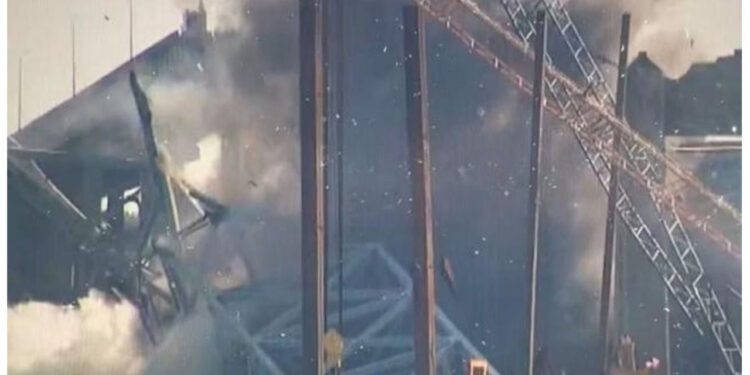The successful removal of the 4,000-ton fragment of the Key Bridge collapse from the Dali cargo ship using explosives on Monday evening marks a significant milestone in the recovery process.
It has been nearly seven weeks since the tragedy claimed the lives of six construction workers, causing severe damage to the Port of Baltimore and disrupting access to the Beltway.
The video captured the moment when the steel pieces tumbled into the water.
The explosion, originally scheduled for the weekend, happened in a matter of seconds, resembling a brief fireworks display.
The plan to fully reopen the main channel in the Patapsco River and restore access to the Port of Baltimore by the end of May is still on track, as Unified Command continues to work diligently.
“Today marks a significant achievement,” declared Lt. Gen. Scott Spellmon, representing the U.S. Army Corps of Engineers.
What happened?
Explosives were strategically placed in the steel and concealed with a sturdy tape to create cuts.
The explosion resembled a display of fireworks, prompting authorities to advise individuals within a 2,000-yard radius to don hearing protection.
According to the U.S. Army Corps of Engineers, this method is considered the safest and quickest way to remove the enormous amount of debris that is holding the ship in place.
Throughout the entire ordeal, over 20 crew members stayed onboard.
“In order to maintain the safety and functionality of the ship, they choose to remain on board as they are an integral part of the vessel,” explained Rear Admiral Shannon Gilreath of the U.S. Coast Guard.
Safety is top priority
Maryland Governor Wes Moore vividly described the meticulous and high-stakes operation involved in detaching the massive steel structure of the ship and safely guiding it into the Patapsco River. The operation required precise timing and coordination, as numerous small explosives were strategically placed to ensure the smooth and controlled descent of the steel.
The event had experienced two delays because of unfavorable weather conditions.
Getting Dali refloated
According to Colonel Estee Pinchasin of the U.S. Army Corps of Engineers, the next course of action involves the removal of the Dali.
It will take a few more days to remove the ship and reopen the channel.
“We will refloat the vessel once the wreckage falls into the channel,” Pinchasin explained. “Our salvors are prepared to retrieve the wreckage, just as they have been doing for the past seven weeks. They will lift it with the grabber and remove it after cutting it down further.”
Body-worn camera footage shows response
The Maryland Department of Natural Resources has recently released body-worn camera footage that captures the immediate response of the police in the aftermath of the bridge collapse on March 26. The video reveals the challenging conditions faced by the officers as they navigated through the dark and debris-filled river.
In the video, officers can be seen responding to the wreckage site by boat, showcasing their dramatic and swift action. One particular clip captures an officer confidently approaching the Dali and engaging in conversation with the crew.
Message for bridge collapse victims
In a heartfelt address, the governor extended his condolences to the families of the six victims who tragically lost their lives. He emphasized that all bodies have now been recovered, bringing some closure to the devastating incident.
“I made a promise that we would use every resource available to bring back your loved ones, and I sincerely hope that we can bring you some solace by keeping our word,” expressed Gov. Wes Moore.
Law firms to assist potential lawsuits
Maryland’s Attorney General has enlisted the support of five law firms to provide assistance in the event of any potential litigation.
The state will pay outside counsel based on the contingent fee arrangement if they successfully recover damages. The request for approval will be presented to the Board of Public Works (BPW) during their meeting on Wednesday, May 15th.
Attorney General Brown expressed his determination to seek compensation for the damages caused by the M/V Dali’s collision with the Key Bridge on behalf of the affected state agencies and the people of Maryland. To achieve this goal, the OAG has formed a team of law firms specializing in maritime disasters, tort litigation, insurance recovery, and dispute resolution.
Several law firms are involved in this case, including Kelley Drye & Warren, Liskow and Lewis, Partridge LLC, The Lanier Firm, and, serving as local counsel, the Maryland firm of Downs Ward Bender Herzog & Kintigh.
Moore assured that those responsible for the tragedy would indeed be held accountable. Lloyds of London has projected that this incident will be the costliest maritime tragedy in history. Moore expressed confidence that the individuals who need to be held accountable will be involved in the process of rebuilding.










